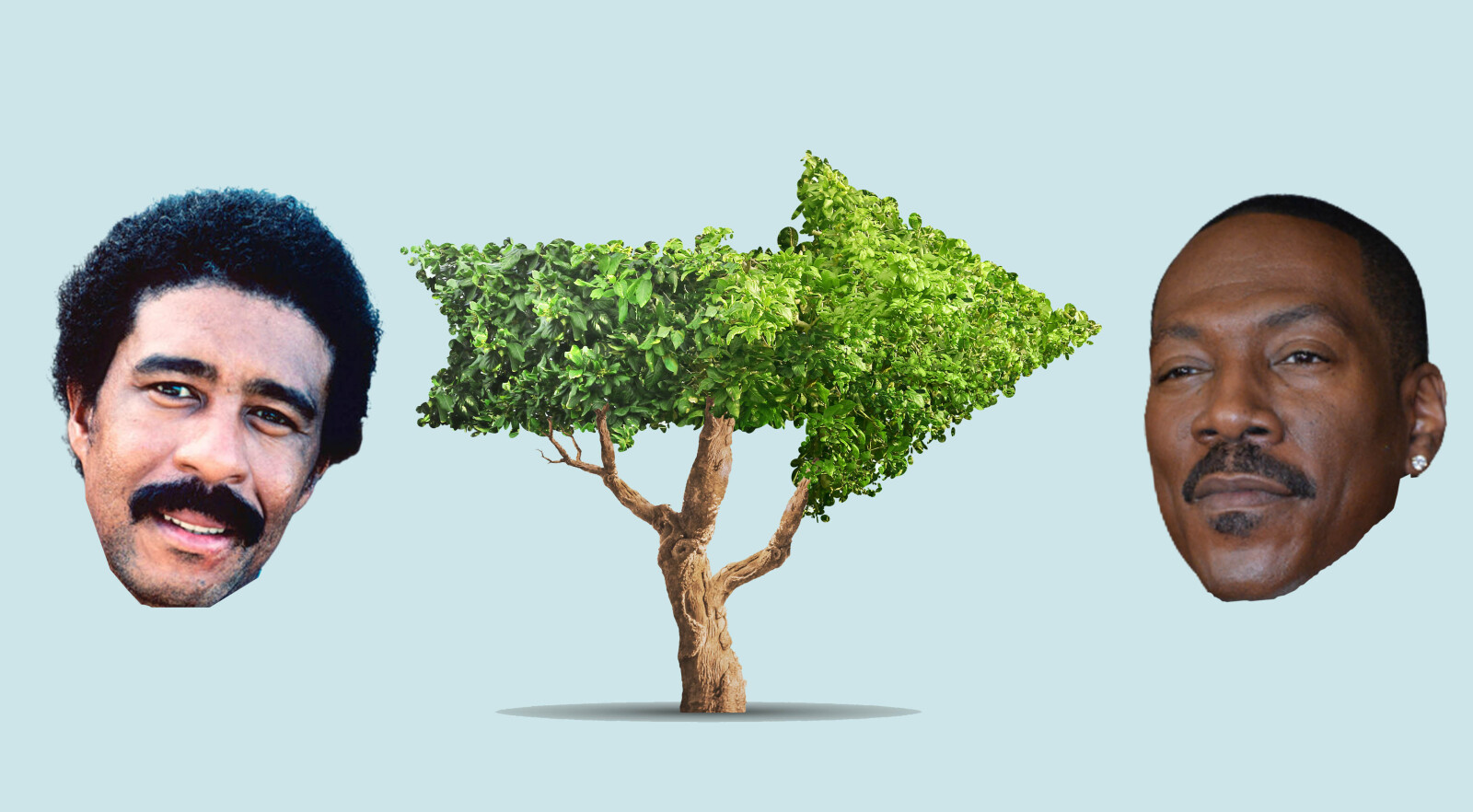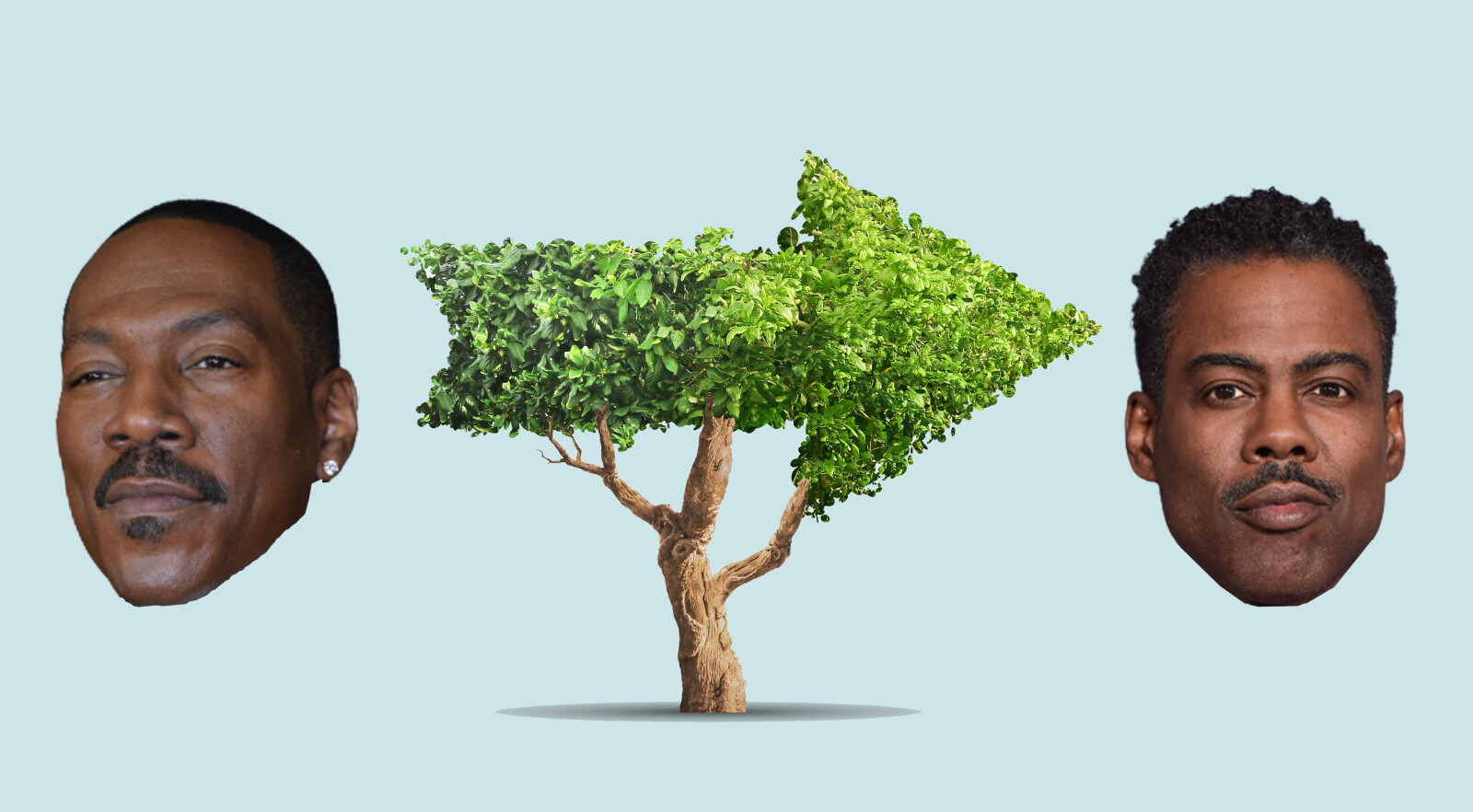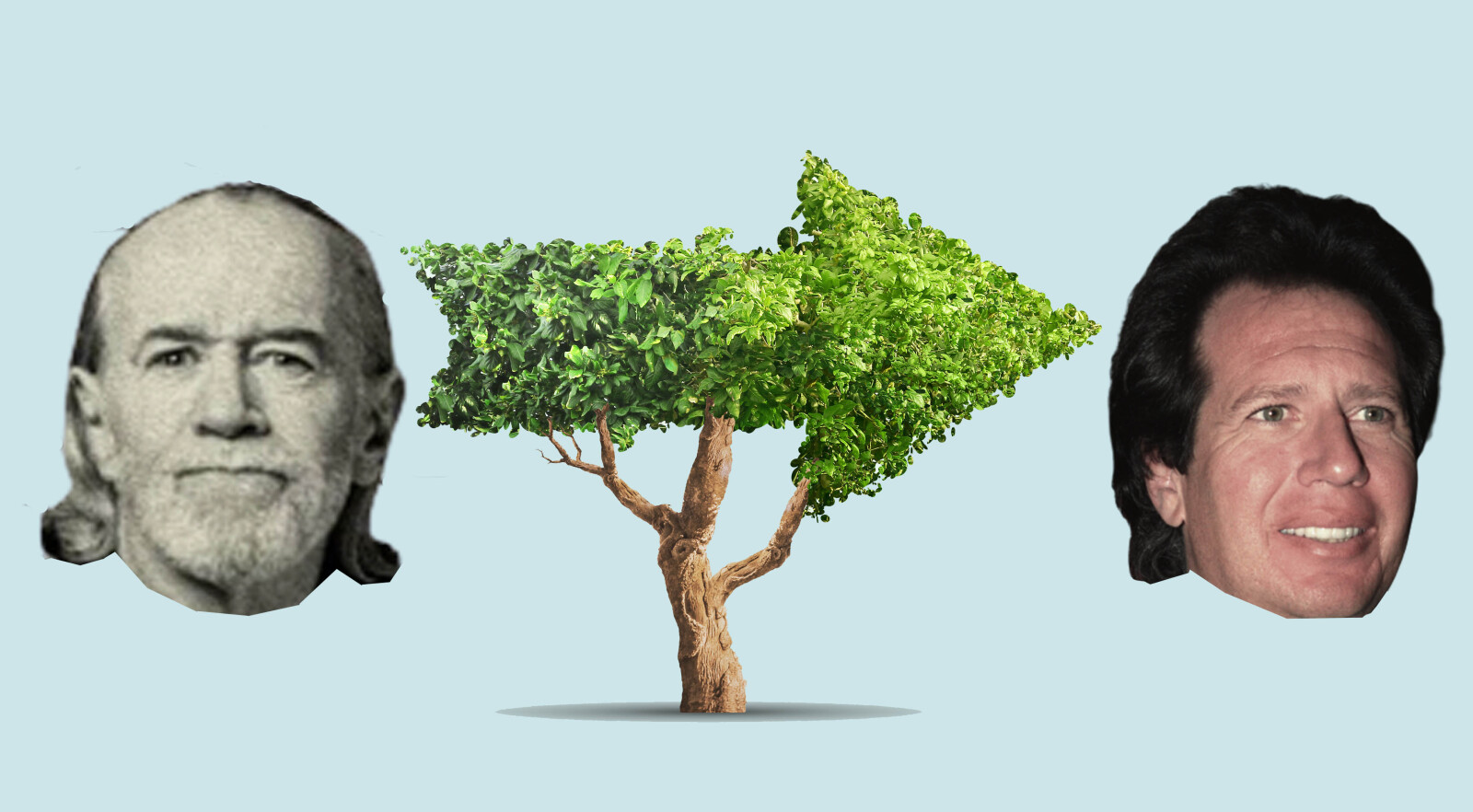Comedy Family Tree: Tracing the Branches from Richard Pryor to Aziz Ansari

Kevin Bacon isn’t the only guy who’s a few degrees of separation from Kyra Sedgwick, the Guardians of the Galaxy and seemingly every other entertainer who ever lived. Two comedians in particular have connections to just about every current stand-up. Apply a little 23-and-me to iconic funny men Richard Pryor and George Carlin, and you can trace their lines of influence straight into the comedy clubs of today.
The Richard Pryor Tree
The Pryor we remember now — the profanity-spewing, confessional comic who forged characters from the fires of his own tormented life — was largely a creature of his own creation. But he was not without his own influences, especially in the beginning.
Surprisingly, the fledgling comic started out imitating a comedian who one day would be his antithesis: Bill Cosby. In the early 1960s, Pryor was fascinated with Cosby’s ability to bypass the Chitlin Circuit (a series of nightclubs that featured shows for Black patrons primarily performed by Black entertainers) and appeal to mainstream audiences. “For a few months, he tried to remake himself as ‘Richard Cosby,’” according to the biography Becoming Richard Pryor. The imitation wasn’t hard to spot. A New York Herald Tribune review in 1964 noted that “comedian Richard Pryor has got guts. He uses Bill Cosby’s style, mannerisms, inflections and much of Cosby’s material without batting an eyelash. Be yourself, Richard, so we can pan (or applaud) you on your own.”
Don't Miss
Soon enough, Pryor took that advice and developed his own style, one that reverberates even now. His most immediate comedy ancestor? Eddie Murphy.

Showtime/Shutterstock
“(Pryor) is the best ever,” Murphy once told Playboy. “You talk about mixing body language with everything else: Richard is like a mime on stage. He can take inanimate objects and make them come alive. Things that aren’t there, he makes you see them, or he’ll become something that he’s talking about. There’s no one who’s ever brought the theatrics that Richard brings to his comedy.”
Murphy points to Pryor as his biggest influence, but that doesn’t mean he was doing an imitation. “Influence isn’t like when you see somebody and go, ‘I’m gonna steal the way he walks or the way he phrases words.’ It’s somebody impressing the shit out of you and you just adapting that to your own thing.”
And you know you’re on your way when you get Pryor’s blessing. Murphy told James Corden about being a young comic and approaching Pryor on a plane with a copy of his first comedy album. Murphy introduced himself but Pryor waved off the pleasantries — he knew who Murphy was already. “(Pryor) put the cassette in, put on the headphones. I was sitting behind him, watching him listening to my record” and laughing away.
When the plane landed, Pryor insisted on giving Murphy a ride to the house where he was staying. “That's the way I met my idol.”

Shutterstock
On SNL’s 40th anniversary show, Chris Rock introduced Murphy’s return to the 30 Rock stage. Makes sense — Murphy was the guy who made Rock believe being a comic was possible. “(Murphy’s success) changed everything. Not only could comedy be a job, it could be a career. I wanted to be Eddie Murphy.”
Murphy was responsible for one of Rock’s first big breaks. He showed up at the Comic Strip in New York one night and, with no Black comics on the bill, he insisted that Rock perform even though the fledgling comic was only there to stack chairs after the show. Murphy was so impressed with young Rock’s set that he gave the Jheri-curled novice his first film role in Beverly Hills Cop II.

The Tonight Show with Jimmy Fallon
“Eddie said I was funny on camera and in print — which is a bigger thing than any manager or agent could do — and he got me on this show called The Uptown Comedy Express,” Rock told Playboy. “When the funniest guy in the world says you’re funny, well…”

Shutterstock
Before the future Parks and Recreation star got famous, Aziz Ansari was obsessed with Rock. “Those two Chris Rock specials, Bring the Pain and Bigger and Blacker, in high school I knew every single word,” he’s explained to Vulture.
Ansari can’t remember exactly how he and Rock became friends, but Ansari has turned to his mentor at so many big stops along the way, from playing Madison Square Garden to doing a monologue at SNL right after Trump’s inauguration. Rock’s advice? For one night, be George Carlin. Be political. “Aziz sought me out and was like, ‘Let’s have dinner, man,’” Rock has said. “I gravitate to young guys that are doing it because I know that’s the only way to keep it going, and Aziz gravitates to old guys that have done it because he knows that’s the secret to the future.”
Following that example, Ansari now is mentoring young Indian-American comics “because if I don’t do it, who will?” Check back in a few years to see how the Pryor branch continues to extend.
The George Carlin Tree
Carlin’s own influences weren’t stand-ups at all, or at least not in the traditional sense. Growing up, young Carlin wanted to be Danny Kaye, an extremely verbal comic in the movies and a funny guy who Carlin wanted to emulate.
But soon enough, Carlin found his way to the stage instead of movies, first as part of a two-man act (Burns and Carlin), then as a suit-and-tie comic before developing the counterculture style that made him an icon. He was also generous with advice, making time to mentor (then) young comics like Garry Shandling.

Shutterstock
While studying business at the University of Arizona, Shandling started writing Carlin-style jokes and monologues as a way to develop his dream of becoming a comic. When he heard Carlin was playing a club in nearby Phoenix, Shandling made the two-hour drive to find Carlin backstage and ask if he’d read his material. Even though Carlin assured young Shandling that he wrote his own jokes, he agreed to take a look.
The next night, Shandling returned, and Carlin had indeed reviewed the gags. “You’re very green,” Carlin told Shandling, “but I think you’re funny. I think there’s something funny on every page. And I think you should pursue it.” And that, according to It’s Garry Shandling’s Book, was the kick in the ass Shandling needed to move to L.A. and pursue his dream.
Shandling later presented Carlin with an American Comedy Award, where Shandling told the crowd about Carlin’s generosity. When Carlin got up to receive the prize, he told the audience, “I’m sorry for encouraging Garry. It’s my fault.”

Shutterstock
And we have Shandling to blame for Judd Apatow. The aspiring comic and writer found his way onto The Larry Sanders Show, and like many who worked on that classic HBO series, Apatow didn’t have an easy time. “It really took me looking him in the eye,” Apatow has explained, “and going, ‘Don’t hate me, Garry. I’m trying.’”
Apatow’s films, often based on his own personal stories or the life stories of their stars (Pete Davidson, Amy Schumer, Lena Dunham, Billy Eichner, Kumal Nanjiani et al), owe a debt to Shandling’s self-confessional style of comedy. “I think that at some point he realized that the journey in his creativity was to just go deep into himself and share his life and his feelings and his story with other people that made his stand-up deeper and richer,” Apatow told WBUR. “He had a great joke where he said, ‘My friends tell me I have an intimacy problem, but they don't really know me.’”
The mentorship continued well into Apatow’s directing career. He had Shandling read the script for The 40-Year-Old Virgin, a story for which Apatow and cowriter Steve Carell couldn’t quite figure out an ending. “Garry kept saying ‘You need to find a way to show that his sex is better than his friend’s sex, because he’s truly in love,’” Apatow told Cinemablend. “And he kept saying, ‘You’ve got to figure out a way to show that!' And I’m like, ‘Garry, I can’t show the sex, I don’t know how to do this ending.’ One day Steve just went, ‘What if I just sing a song?’ and I said, ‘Yeah, like ‘Let the Sunshine In.’ And we said, ’Oh, that sounds good!’”
Also, added Apatow, that climatic ending is the only time you’ll see Seth Rogen dance like that. Which brings us to…

Shutterstock
Rogen was just a kid — literally, he was 16 — when he was cast in Apatow’s Freaks and Geeks. But that didn’t stop the duo from transitioning into another kind of relationship entirely, a partnership that defined 2000s comedy with hits like Knocked Up and Superbad. “People talk a lot about me being a mentor to Seth, or having discovered Seth when he was a kid,” Apatow explained in Sick in the Head: Conversations about Life and Comedy. “But here’s the truth: Seth’s sense of humor has influenced everything I have done.”
Now that Rogen is a movie producer, “I definitely look back on how I was very overtly mentored.” As he told Vulture, Apatow was crucial with instructions on, “‘Here’s how you write a comedy scene. Here’s why Larry Sanders Show was funny. Here’s how we tracked the emotions of the episodes.’ And Judd explaining to me like, ‘Here’s how Jim Brooks would explain to us on The Critic how a scene should be written.’”
And the comedy circle of life continues as Rogen tutors the next generation: “I try to explain things. I don’t want to f***ing just run my mouth off, but if people seem genuinely curious, I try to take the time to explain what it is we’re doing and why we’re doing it. I very much try to find people that I genuinely think are funny and hire them and bring their work to life.”